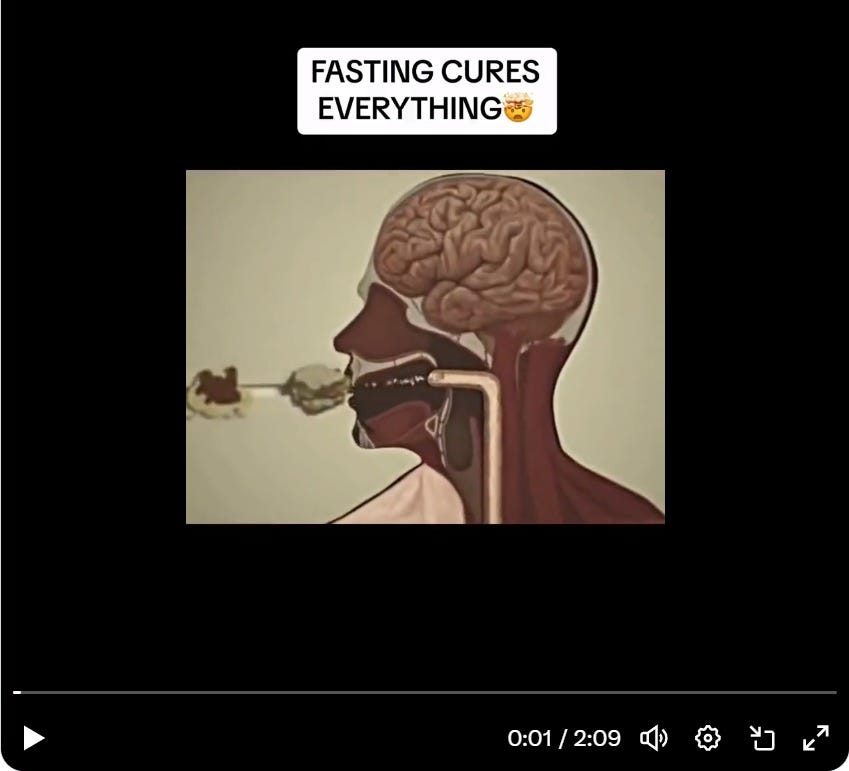October 13, 2023 | Health Prepping, Part 3: Intermittent Fasting

This is the third in a series (the other two are here and here) based on the idea that to be cheerfully ungovernable in the coming dark times, first and foremost you have to be healthy. And there are lots of ways (many of which your doctor won’t bother mentioning) to achieve that. Here’s an easy one.
Intermittent fasting
These days, most of us spend our time sitting and staring at screens. But in evolutionary terms, we’re still hunter-gatherers who are optimized for two things: regular exercise and irregular eating. Our earliest ancestors gorged when they found a tree full of ripe fruit or brought down a mammoth. And they fasted during the lean times in between.
Our bodies, as a result, are set up to use this metabolic downtime productively. And if we aren’t hungry every once in a while we fail to activate those beneficial processes. Put another way, what we eat matters, but so does when and how often we eat.
Adopting a modified version of feast-or-famine (read on for examples) is now recommended by a growing number of mainstream scientists. It’s called “intermittent fasting (IF),” and studies show that it’s good for virtually everything that ails modern couch potatoes.
The mechanisms
Metabolic switching. After a few hours without food, the body exhausts its sugar stores and starts burning fat which, it turns out, is a much cleaner fuel than carbs.
Cellular repair. Fasting triggers autophagy, a process where cells recycle and repair damaged components, increasing their efficiency and eliminating the toxins produced by unhealthy cells.
Here’s a video that explains this in more detail:

The benefits
These are pulled from various online lists:
Weight Loss. If you refrain from going crazy during your eating periods (that is, if you eat reasonable amounts of healthy food — a subject for a future post) you end up with fewer calories each day, which over time helps you lose weight.
Improved insulin sensitivity, potentially reducing the risk of type 2 diabetes.
Enhanced brain function. Studies show that intermittent fasting boosts working memory in animals and verbal memory in adult humans. From the National Institutes for Health: “If you don’t eat for 10–16 hours, your body will go to its fat stores for energy, and fatty acids called ketones will be released into the bloodstream. This has been shown to protect memory and learning functionality, as well as slow disease processes in the brain.”
Longevity and disease resistance. Autophagy (see the above video) gets rid of sick, toxic cells, which slows the aging process.
Heart health. Intermittent fasting improves blood pressure, resting heart rates, and other heart-related measurements.
Physical performance. Young men who fasted for 16 hours showed fat loss while maintaining muscle mass. Mice who were fed on alternate days showed better endurance in running.
According to a Johns Hopkins researcher: “Many things happen during intermittent fasting that can protect organs against chronic diseases like type 2 diabetes, heart disease, age-related neurodegenerative disorders, even inflammatory bowel disease and many cancers.”
Choose your schedule
There are lots of ways to fast intermittently. Some popular examples:
16/8: Fast for 16 hours each day and restrict eating to an 8-hour window. Personal note: I do this and it’s easy. Stop eating at 7pm and delay breakfast until 11am. Very little willpower needed.
5:2: Eat normally for five days a week and significantly reduce calorie intake (usually around 500-600 calories) on the other two non-consecutive days.
Eat-stop-eat: Fast for a full 24 hours once or twice a week.
Alternate-day fasting: Alternate between days of normal eating and days of either very low-calorie intake or complete fasting.
More resources
People with chronic stress and depression are 4 times as likely to develop Alzheimer’s (MarketWatch)
Effects of intermittent fasting on health, aging, and disease. de Cabo R, Mattonson MP. New England Journal of Medicine, December 2019
Effect of Alternate-Day Fasting on Weight Loss, Weight Maintenance, and Cardioprotection Among Metabolically Healthy Obese Adults: A Randomized Clinical Trial. JAMA Internal Medicine, May 2017
Alternate-day fasting in nonobese subjects: effects on body weight, body composition, and energy metabolism. American Journal of Clinical Nutrition, January 2005
The Obesity Code, by Jason Fung, MD (Greystone Books, 2016)
Intermittent fasting interventions for treatment of overweight and obesity in adults: a systematic review and meta-analysis. JBI Database of Systematic Reviews and Implementation Reports, February 2018
Metabolic Effects of Intermittent Fasting. Annual Review of Nutrition, August 2017
Early Time-Restricted Feeding Improves Insulin Sensitivity, Blood Pressure, and Oxidative Stress Even without Weight Loss in Men with Prediabetes. Cell Metabolism, May 2018
The Complete Guide to Fasting, by Jason Fung, MD (Victory Belt Publishing, 2016)
STAY INFORMED! Receive our Weekly Recap of thought provoking articles, podcasts, and radio delivered to your inbox for FREE! Sign up here for the HoweStreet.com Weekly Recap.
John Rubino October 13th, 2023
Posted In: John Rubino Substack











